The Less Risky Varieties, Old and New
Bruce I. Reisch and Steve Luce
NYS Agricultural Experiment Station
Cornell University
Geneva, New York
Presentation to the Finger Lakes Grape Growers' Convention, March 4, 2005
Some of the following information is derived from Cornell Information Bulletin 233, Wine and Juice Grape Varieties for Cool Climates, co-authored by Bruce Reisch, Robert Pool, David Peterson, Mary-Howell Martens and Thomas Henick-Kling. See the following internet sites for further details:
Cornell Information Bulletin 233: Wine and Juice Grape Varieties for Cool Climates
New Wine and Table Grape Selections from the Geneva Grape Breeding Program
Grape growers would like to produce crops reliably every year, but the harsh recent winters have taken a great toll. As a result, some growers are seeking to fill in existing vineyards where some vines have died, and other growers are re-considering what they will plant in the future. This talk will summarize some of the options among the interspecific hybrid varieties, with some emphasis on a comparison of their ability to withstand severely cold episodes in mid-winter.
The breeding program vineyards at the Experiment Station in Geneva experienced low temperatures in the range of -14 to -17 F during the winters of 2003/04 and 2004/05. Information presented below on spring 2004 percentage of live nodes is indicative of the range of survival experienced following these temperatures, though the precise temperature at each plot, as well as vine age and crop level, varied.
While this presentation focuses on cold hardiness among a range of red and white wine varieties, choices should not be made on this factor alone. Consideration should also be given to wine quality, relative disease resistance, productivity, market demand, and much more. It's important to match the variety to the site - if you have a site that is known to be relatively cold for the region, then consider your options among the most cold hardy varieties. On the other hand, a better site in terms of expected mid-winter temperatures could be considered for higher quality, less hardy hybrids or vinifera varieties. Diversification is also an important consideration. By planting several varieties, a grower can better withstand the fluctuations in crop levels on his/her less hardy varieties by counting on the more reliable production of more hardy varieties.
Below is a brief table with overall ratings of cold hardiness among a range of some of the most important hybrid (ie. "less risky") varieties available. Further descriptions of these varieties, and more details on the level of bud and trunk hardiness follow in the individual variety summaries found below the table. As always, the level of relative hardiness will also be affected by cultural practices (disease management, crop level, etc.), site characteristics and climatic differences from year to year. Vinifera varieties are all grouped into a single category. In fact, they are known to vary greatly for level of cold hardiness. For the purposes of this table, they are grouped only into a single category to show, in a general sense, their hardiness in relation to categories of hybrid wine grapes.
| |
Red Wine Grapes
|
White Wine Grapes
|
|
Most Hardy:
|
Frontenac
GR 7
Maréchal Foch
St. Croix
|
La Crescent
Ravat 34
NY76.0844.24
Vignoles <?>
|
|
Intermediate Hardiness:
|
NY70.0809.10 |
Traminette
NY62.0122.01
|
|
Less Hardy Hybrids:
|
Chambourcin
Chelois
NY73.0136.17
|
Cayuga White
Vidal blanc
|
|
Least Hardy:
|
(vinifera)
|
(vinifera) |
Interspecific Varieties for Red Wine Production
|
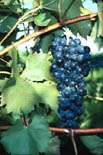
Chambourcin
|
Chambourcin (Joannes-Seyve 26-205) is a late ripening grape which may produce a highly rated red wine when fruit fully matures. It requires a long growing season and a site less subject to low winter temperatures. The large, moderately loose bunches set medium sized blue berries. The vine is very productive and cluster thinning is required.
Spring 2004 % live nodes : 13% (based on a small sample of one older vine and 3 newly planted vines) |
|
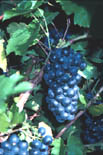
Chelois
|
Chelois (Seibel 10878) wine quality ranks highly among the French-American hybrids. It has, however, experienced a major decline in
acreage in New York as demand for red wine decreased during the 1980's. There has been a resurgence of interest in Chelois in the early 1990's as consumer interest in red wine
again increased. Chelois is suitable for blending with other red hybrids (Chambourcin, Baco noir and Chancellor) or V. vinifera varieties.
Vines are healthy, vigorous and productive, but require cluster thinning to prevent overcropping. Berry splitting and subsequent bunch rots may be severe in some years.
Because of susceptibility to winter damage, Chelois should be planted on better sites. Small blue-black berries are borne on compact, medium-sized clusters. |
|
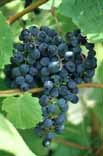
Frontenac |
Frontenac is a red wine grape (Landot 4511 x V. riparia) from the University of Minnesota, released in 1996. The vine is extremely vigorous, productive, and cold hardy. Foliage and fruit are highly resistant to downy mildew, and the fruit are resistant to Botrytis bunch rot. High sugar levels along with high acidity are typical at harvest. The acidity usually requires some adjustment during the wine-making process. Wines have been characterized by some tasters as having deep color with elderberry, cherry, and perfumy notes. Other tasters have found it to be too vinous and candy-like.
Spring 2004 % live nodes: 86%
Trunks: very hardy
More information on Frontenac
Frontenac Gris is a grey-fruited sport of Frontenac used to make white wines. The vine has essentially the same vineyard characteristics as Frontenac. However, the wine is quite different, said to have peach, apricot, pineapple and citrus aromas, with no herbaceous or labrusca character. This variety has not been tested at the Geneva Experiment Station. |
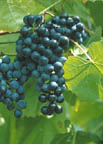
GR 7 |
GR 7 - ("Geneva Red 7") - (Buffalo x Baco noir) highly vigorous, highly productive and winter hardy, with moderate resistance to diseases. 'GR 7' makes dark red wines with a classical hybrid aroma. It has better tannin structure than Baco noir and De Chaunac. It still has a short finish. It is best made as a light (not heavily extracted) wine. Use hot pressing, short skin contact time or some carbonic maceration. It has a place in traditional red hybrid blended wines, and is already in limited commercial production.
Predicted temperature of 50% primary bud kill in mid winter = -17.1 F *
Spring 2004 % live nodes: 93%
Trunks: very hardy
|
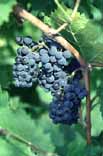 Maréchal Foch Maréchal Foch |
Maréchal Foch (Kuhlmann 188-2) is a very early ripening black grape with small berries and clusters that produce a fruity light red table wine. The vines are hardy and medium in vigor and production. Maréchal Foch should be grafted on a resistant rootstock to ensure adequate vigor. Birds are attracted to the small black berries.
Spring 2004 % live nodes: 87%
Trunks: Very hardy
|
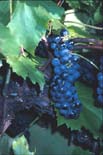
St. Croix |
St. Croix (Plant patent 4928) bears medium sized blue berries on medium clusters. The vine is very hardy, vigorous, and disease resistant; very precocious in bearing. Cluster thinning may be required.
Trunks and Buds: Very hardy
More information on St. Croix |
Interspecific Varieties for White Wine Production
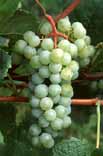
Cayuga White |
Cayuga White, named at Geneva in 1972, is one of the most productive and disease resistant varieties grown in New York. Its wine has been highly rated, having medium body, and good balance. An important positive attribute is its versatility; it lends itself to making semi-sweet wines emphasizing the fruity aromas, and is also made as a dry, less fruity wine with oak aging. When harvested early, it may produce a very attractive sparkling wine with good acidity, good structure, and pleasant aromas. When over-ripe, however, it can develop strong hybrid aromas with slight American overtones. The excellent cultural characteristics and high wine quality indicate an important future for this variety in New York.
Predicted temperature of 50% primary bud kill in mid winter = -12.0 F *
Spring 2004 % live nodes: 22%
Some ability to produce reasonable crop, despite bud damage, due to large cluster size
Trunks: double-trunking recommended. Some trunk damage expected following cold episodes. |
|
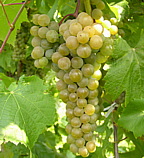
La Crescent
|
La Crescent is a recent introduction (2002) from the University of Minnesota, formerly known as MN1166. Noted for its excellent winter hardiness and suitability to northern climates, it is usually harvested at mid-season. The white wine has a distinct apricot, citrus and pineapple aromas, and is also suitable for blending. Yields are moderate.
Predicted temperature of 50% primary bud kill in mid winter = -18.2 F *
Spring 2004 % live nodes: 86%
Trunks: very hardy
More information on La Crescent |
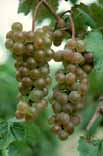 Ravat 34
Ravat 34 |
Ravat 34 is a selection of the French hybridizer, J.F. Ravat. It is early ripening, moderately vigorous, productive and winter hardy. Wine quality is good. There is limited commercial experience with this variety in New York. Yield trial results from Fredonia, New York indicate excellent potential.
Predicted temperature of 50% primary bud kill in mid winter = -17.3 F *
Spring 2004 % live nodes: 68%
Trunks: very hardy |
|
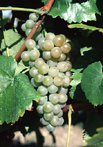
Traminette
|
Traminette was named and
released at Geneva in 1996. This Gewürztraminer hybrid produces wines
of excellent quality similar in aroma to its well-known parent. There
is good balance in the must between levels of sugar, acid, and pH. The
vine is much more winter hardy than its Gewürztraminer parent, moderately
productive, and just slightly susceptible to powdery mildew and Botrytis.
Maturity is late mid-season, Oct. 5-10 in Geneva.
Flavor expression with Traminette is best when the must
is given some (24 to 48 hours) skin contact with 50 mg/L SO2 at 5 C. Wines
made with skin contact do not develop objectionable bitterness or high
pH, though this should always be monitored. If necessary, pH should be
adjusted before fermentation (should be no higher than 3.4). In fruit
grown in warmer regions increased bitterness and a high pH must might
become a problem. Then shorter skin contact time should be used. If very
long skin contact times are used, the typical floral / spicy Gewürztraminer
flavors may shift to muscat-like flavors.
Typically, the wines made with some skin contact have
strong spice and floral aromas, a full structure, and long aftertaste.
The wine can be made dry or sweet. Mouthfeel of the dry wine is good with
nice texture and good spice feel.
Predicted temperature of 50% primary bud kill in mid winter = -15.7 F *
Spring 2004 % live nodes: 64%
Trunks: moderately hardy; some damage observed in 2004. Averaged 7 lbs fruit/vine in 2004.
|
|

Vidal blanc
|
Vidal blanc (Vidal 256) is a heavily productive white wine grape which produces good quality wine when the fruit reaches maturity. It requires sites with long growing seasons and moderate winter temperatures. Small berries are borne on very large, compact, tapering clusters. Cluster thinning is required to prevent overcropping. Plantings in New York increased from 35 acres in 1975 to 152 in 1990.
Spring 2004 % live nodes: 13%
Trunks: moderately hardy; some aerial roots observed 2004. |
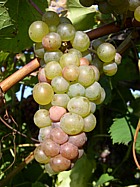
Vignoles |
Vignoles (Ravat 51) produces an excellent dessert wine, especially when picked late. The fruit can develop very high sugar content while acidity remains high. Vines are hardy with moderate vigor and productivity. Bud break is late, reducing the risk of spring freeze injury. Clusters are small, very compact and very susceptible to Botrytis bunch rot. Acreage doubled between 1975 and 1990.
Spring 2004 % live nodes: 79%
Trunks: hardy, no damage at Geneva in 2004.
|
Recent Selections from the Cornell Grape Breeding Program
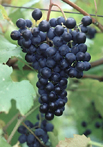
NY70.0809.10 |
NY70.0809.10 - (SV 18-307 x Steuben) produces a highly ranked light-bodied, vinifera type wine. The vine is vigorous and very productive at Geneva. Some cluster thinning is usually required to avoid overcropping. Vines are healthy with good powdery mildew and Botrytis rot resistance and often maintain green leaves up until frost. Fruit maturity is late, with harvest Oct. 10-20 in Geneva.
Predicted temperature of 50% primary bud kill in mid winter = -15.1 F (mean for 1996-2002)
Predicted temperature of 50% primary bud kill in mid winter = -16.6 F * (winter 2004/05)
Spring 2004 % live nodes: 75%
Trunks: Moderately hardy. Among 13 vines, 8 had no damage, and 5 were either killed to the ground or had crown gall.
|
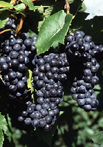
NY73.0136.17 |
NY73.0136.17 - [(NY33277 x Chancellor) x Steuben] produces an excellent full-bodied wine with a distinct pepper character and moderate tannin content. Vines have generally been vigorous and productive in the Finger Lakes of New York, though older vines occasionally show a slow decline in vigor that may be indicative of a need for grafting. The leaves show moderate resistance to powdery mildew, but both fruit and leaves require a regular spray program to control downy mildew. Fruit maturity is mid-season, approx. Oct. 1 in Geneva.
Predicted temperature of 50% primary bud kill in mid winter = -14.3 F *
Spring 2004 % live nodes: ~53% (very little fruit production)
Trunks: Expect some damage after cold winters. All 14 vines at Geneva required trunk renewal in 2004. If grafted, the graft union must be protected by hilling up in the fall.
|
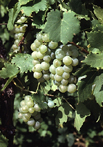
NY62.0122.01 |
NY62.0122.01 - (Couderc 299-35 x Muscat Ottonel) produces an excellent, high quality muscat wine that may be made into a dessert wine or used in blending. Own-rooted vines are small (1.4 lb./vine in Geneva), and therefore grafting is recommended. Though grafting improves vine size, planting at somewhat closer than normal spacing (approx. six feet between vines within rows) may also improve vineyard productivity. Foliage is moderately susceptible to powdery mildew, downy mildew and black rot. The fruit is highly flavored, very juicy, and ripens mid-season.
Predicted temperature of 50% primary bud kill in mid winter = -14.8 F *
Spring 2004 % live nodes: 28%
Trunks: Moderately hardy. Some trunks were damaged in 2004.
|
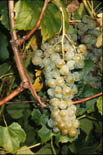
NY76.0844.24
|
NY76.0844.24 - (Traminette x Ravat 34) makes a top ranked floral, muscat wine. Own rooted vines have been highly productive, highly vigorous (24 lbs. of fruit/vine; 4.3 lbs. pruning weight average for '96-'03) and very winter hardy. Clusters are large and loose. Leaf phylloxera have been an occasional problem. Maturity is mid-season, ripening in mid-late September in Geneva.
Predicted temperature of 50% primary bud kill in mid winter = -16.8 F *
Spring 2004 % live nodes: 81%
Trunks: Very hardy.
|
Return to Grape Breeding Program | Return to Finger Lakes Grape Program
Page last modified 7 October 2005, bir










